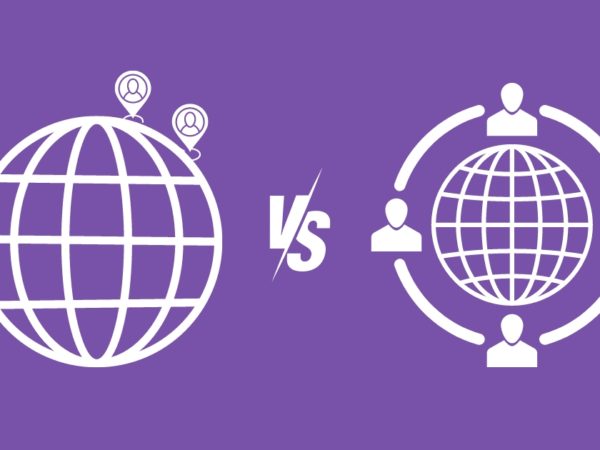<img alt="employee-stocks-purchase-geekflare" data- data-src="https://kirelos.com/wp-content/uploads/2023/10/echo/employee-stocks-purchase-geekflare.jpg/w=800" data- decoding="async" height="420" src="data:image/svg xml,” width=”800″>
When Zomato, an Indian multinational restaurant aggregator and food delivery company, went public in July 2021, 18 of its employees became millionaires. 🤯
This happened because the employees were holding ESOPs of Zomato.
ESOP stands for Employee Stock Ownership Plan. It gives employees an option to buy the company’s shares at a massively discounted price and then sell them at a pre-determined higher amount (exercise amount) or market value of the share if the company goes public.
ESOPs give employees an opportunity to create wealth due to value buying. Also, employees get an additional source of passive income through dividends.
Even though ESOPs sound lucrative, there are various terms and conditions that you need to understand before accepting or rejecting them. You need to know about the Cliff period, the Vesting period, the Exercise period, and most importantly, how your ESOPs will be taxed.
In this complete ESOP guide, you will learn everything about ESOP, its terms and conditions, and whether you should accept ESOPs as a part of your salary package.
What is an Employee Stock Ownership Plan (ESOP)?
Employee Stock Ownership Plans (ESOP) are offered to newly hired employees when discussing their CTC, i.e., Cost to Company. It is alternatively known as Stock Options as well.
One thing to understand very clearly beforehand is that ESOPs are not stocks or shares of the company. With Stock Options, the employee has an option to buy the stocks or shares of the company in the foreseeable future.
For example, you get 100 ESOPs when joining an organization, and each ESOP is valued at USD $10 – that’s USD $1000 worth of ESOPs.
After 6 months, your organization is sold to a conglomerate in a multi-billion dollar deal. Or, your organization sees exponential sales in the financial year. Or, your company merges with a giant company from the same domain.
In any case, each ESOP is now valued at USD $20, and you hold 100 ESOPs. So, now you can exercise your Stock Options right and cash out by selling your 100 ESOPs at USD $20 – meaning, you walk away with USD $2000.
ESOPs are mainly offered by early-stage startups that see a huge valuation boost or growth potential in the near future. This is mainly done to make their salary package look more attractive to the employees to improve employee morale and boost intrapreneurship.
Stock Options are also offered by companies when they want to hire talented employees but lack the cash reserves to offer a high salary package, but still want to practice salary benchmarking.
What is the Vesting Period?
ESOPs are popular in the United States. In fact, according to the National Center for Employee Ownership, there are 6,400 ESOPs in the United States, covering over 14 million participants and holding total assets of over $1.6 trillion.
However, an employee must remember that these Stock Options are not given to you all at once. The allocation is distributed over a period which is called the Vesting Period. In the United States, the Vesting Period ranges from 1 to 5 years.
If you accept the ESOP as a part of your salary package, you will be given a Grant Letter. In this letter, you will find two terms: Cliff and Vesting Period/Schedule.
The Cliff is a period (minimum number of months) of employment that needs to be completed before the employee is eligible to receive ESOPs. In most companies, the Cliff period is up to 12 months.
After the Cliff period, the Vesting period begins. This is a period of 1 to 5 years. In this period, the ESOPs are systematically allotted to the employees. The company can allot ESOPs quarterly, semi-annually, or yearly.
In some cases, companies can even allot ESOPs percentage-wise. For example, after the Cliff period, you must complete one year for 10% of the agreed ESOPs, then you get 20% after one more year, then 30%, and finally, the remaining 40%.
Some companies who genuinely care a lot about their highly talented employees can even reverse this allotment order as a form of employee recognition. This means you will receive 40% of ESOPs after completing one year of employment, and so on – providing you’ve completed the Cliff period.
(Although, this way to boost employee morale is very rare! 😂)
Also, you must remember that the Vesting schedule depends on the company’s policy.
They can even combine fixed and percentage methods, meaning they will provide a fixed number of ESOPs after completion of the Cliff period one year of employment, and then the remaining shares will be allotted percentage-wise every six months.
What Does Exercising ESOPs Mean?
This is the most crucial part when deciding whether to accept ESOPs as a part of your salary package.
The Exercising period is a pre-defined period in which you can exercise your right (option) to convert your ESOPs into actual company shares. If you do so, you will receive the shares at a massively discounted, pre-defined price, irrespective of the share’s current Fair Market Value (FMV).
This Exercise period can range from 3 months to multiple years. Hence, you should read your company’s policy regarding ESOPs very carefully and understand the exercising rights and period.
⚠ If you fail to exercise your ESOPs within the Exercise period, your ESOPs will lapse. You won’t be able to claim any profits or capital gains if your ESOPs lapse.
One important thing that you need to remember when exercising your ESOP is that you are paying money out of your pocket to convert that ESOP into shares.
For example, I joined a company called XYZ and accepted an ESOP as a part of my salary package. Each year, I will be given 50 ESOPs. After two years of employment, I decide to leave the company with 100 ESOPs.
My Grant Letter mentions an exercise amount of $10/share. So, even if the company’s FMV is $50/share, I can still convert my 100 ESOPs into shares at the exercise price, i.e., $10/share.
Even though it sounds lucrative, it is not as easy as it looks. And you should not exercise if you do not know the taxation on ESOPs.
Taxation on ESOPs
Many employees only know the hunky-dory picture of companies going public and their ESOPs making them millions of dollars. However, there’s a very odd chance of that happening.
However, before that happens, there are taxes on ESOPs that you need to know about. Let’s see how ESOPs are taxed in different countries.
United States of America
In the US, employees with ESOPs do not pay tax on stock allocated to their accounts until they receive distributions. They are taxed when they cash out their ESOPs and get the shares – basically, exercise their ESOP.
If the employee is under 59½ (or, in the case of terminating employment, under age 55), the ESOP distributions received are taxed under the standard applicable tax rate. This is because the ESOP distributions are considered early withdrawals.
Along with the standard tax rate, you also pay a 10% excise tax. This additional tax is commonly called a penalty tax on ESOP distributions. However, if the participant’s employment ended due to death or disability, the ESOP distribution is not subject to the additional 10% ESOP distribution tax penalty.
To avoid this 10% excise tax, you can roll over the ESOP distributions into a traditional or Roth Individual Retirement Arrangement (IRA) or into a retirement savings plan like a 401(k) plan with a new employer.
This rollover is done mainly to defer the income tax on the ESOP distribution. You have 60 days to complete the ESOP into an IRA. Funds become subject to the plan’s rules into which they have been rolled over.
If you want to roll over to Roth, the distribution income is taxed as ordinary income – no 10% excise tax. The funds are rolled over into a Roth IRA, where the funds can grow and remain tax-free.
Dividends paid on ESOPs are not subject to the 10% excise tax. They are exempt from income tax withholding — but dividend payments are fully taxable.
On conversion of options to actual company shares, the employee will pay ordinary income tax on the value of the company’s contributions to the plan, plus capital gains tax on any appreciation in the value of the shares when they sell them.
If the ESOP distributions are $10 or more, the ESOP trustee or a third-party administrator (TPA) must prepare and submit Forms 1099-R and 945 for ESOP taxation reporting.
Europe
According to Index Ventures, there are four points at which ESOPs are taxed in Europe. Please remember that the tax rates may vary from country to country.
- Grant: Some countries in Europe consider the stock option issue a taxable benefit. This tax rate is based on the Fair Market Value of the shares. This discourages many employees and employers from accepting ESOPs as a part of their salary package.
- Vesting: In some European countries, a Stock Options holder is even taxed on the vesting of the ESOPs, even if they don’t exercise immediately. However, this is only in a few countries.
- Exercise: When exercising the Stock Options, the employee is taxed – just like outside Europe. Tax is applied to the spread between strike price (exercise price) and fair market value when exercising the Options. This transaction is considered a deemed income rather than a capital gain. Thus it is taxed under income tax rates.
- Sale: This is common everywhere. The employees are taxed on the appreciation of their share value after exercising their ESOPs. However, the tax rate applied varies from country to country.
Some European countries treat the profits as income; others as a capital gain. So, keep that in mind as well.
Singapore
According to the Inland Revenue Authority of Singapore, gains from ESOP are taxable if you received them while working in Singapore. The ESOPs are taxed in the year they are exercised.
If your ESOP comes with selling restrictions, you will be taxed in the year the restrictions lift. With the Qualified Employee Equity-based Remuneration Scheme (QEEBR scheme), you can get tax deferment on ESOP gains for up to 5 years.
For native employees who leave Singapore or are foreigners, the Deemed Exercise Rule or Tracking option is applicable.
Australia
Australian employees can defer tax until they actually receive a financial benefit from the options, such as conversion of options to shares or capital appreciation on shares. Additionally, employees have up to 15 years to defer their tax liability.
The earliest of the following events are considered for taxation:
- Employee leaves the company that offered them ESOPs
- 15 years after the employee acquired the right
Also, there are no restrictions on exercising the right, and there is no real risk of the employee forfeiting the right.
India
Exercise Price
The Exercise Price is mentioned in the ESOP grant letter, and you should check it along with your ESOP exercise period. This is the price at which you can buy the company’s shares in case you decide to exercise your Stock Options.
If you decide to exercise your ESOPs for shares, you pay this exercise price out of your own pocket.
Tax Collected at Source (TCS)
Exercising your Stock Option and collecting the company shares at a discounted price is considered a deemed income for the employee.
The employer will tax the employee at the time of exercising. In most cases, it is according to the employee’s income slab. This can go up to 30% of the total in some countries.
Capital Gains Tax
Now that you have the shares in your demat account, you are obviously going to hold it, hoping that the company goes public and you make some multifold gains on your shares.
So, if and when you sell the shares at a profit, you will be taxed according to your country’s tax laws. Mainly, it will be the long-term capital gains tax (LTCG), i.e., selling after 1 year. LTCG is 10% of the gains after deducting 1 Lac.
For short-term capital gains (selling before 1 year), you must pay 15% of the gains after deducting 1 Lac.
This is why ESOPs are very dicey to accept, especially when the exercise period is too low, such as 3 or 6 months. Because if you do not have the capacity to pay the exercise price before the exercise period expires, you might lose out on your ESOPs forever.
Win and Lose Cases in ESOPs
In the case of a publicly listed company, it is easy to sell off your shares. You sell the shares at the current market price and collect your profits. However, you will have to pay a Capital Gains tax.
The case is a little tricky if you hold ESOPs of an unlisted private company or an early-stage startup. Primarily, there are four cases when you can cash out your ESOPs and make a huge return.
Initial Public Offering (IPO)
Let’s say you joined an early-stage startup. You have completed 7 years of employment with them, and all your ESOPs are vested. Now, the company has decided to go public by launching its IPO.
When the company goes public, your ESOPs are automatically converted to shares; whatever capital appreciation is, you can liquidate your shares.
It’s your choice to sell off the shares and book profit or hold on to them because you think the company shares can give more profits in the future.
Company Takeover
Let’s say your company, instead of going public, is sold off to a mega-company. Obviously, the company that takes over will be much bigger than your startup.
The acquiring company buys the shares of minority stakeholders (ESOP holders) and liquidates them. This is done to have maximum control over the bought company.
The company can even swap its shares with your current Stock Options – giving you better quality shares with higher value that are prone to liquidation.
Buy Back
Buyback is a process where your company buys back its ESOPs from you. This is mainly done to correct the company’s capital structure or when the founders are confident that their company’s shares will grow exponentially.
A buyback can also be a good sign because this means that, most of the time, the company is planning to go public soon or is expecting a stellar IPO. Buying back shares lets founders and executives pocket more money from the IPO.
Secondary Sale
A secondary sale is when your colleague buys your ESOPs by paying you a bit more than the current value of your ESOPs. Let’s say you know an investment banker who wants to buy your $25,000 worth of ESOPs for $100,000.
If you want to liquidate your ESOPs this way, you need your company’s approval and follow a proper legal procedure.
How Do You Decide Whether to Accept ESOP or Not?
After a certain number, a higher salary doesn’t entice you anymore. At this stage, most people want other motivational factors, such as a great workplace, work flexibility, or a wealth creation opportunity like ESOPs.
Here’s a simple rule that can help you decide whether you should accept ESOPs as a part of your salary package:
If you are joining a company in its early funding stage and getting a decent amount of ESOPs, for example, $30,000 to $50,000, then it’s a good bet.
However, you should analyze these company’s fundamentals to know if there’s a growth potential or discuss with the HR about the company’s plans to go public. If the company is sure to go public, you will get multifold returns on your Stock Options.
Keep in mind that early-stage startups do carry the risk of shutting down, but at the Seed or a Series A level, within a year or two, you will know if the company’s going up or down.
If you do not see the growth potential, resign and try your shot at a different company, or try your hand at becoming an entrepreneur yourself! Whatever you choose to do, even if the company doesn’t go public but is sold off at a decent valuation, you stand to make good returns on your ESOP.
If the company is in a late stage of funding, for example, Series D, and you get a few Stock Options, I’d still say to take that bet. Because if the company has raised so much money, it can still give you stellar IPO returns and capital appreciation for you.
So, I hope this comprehensive guide on ESOPs has helped you decide whether to accept stock options as a part of your salary package or not.
Next up, interested in stocks? Check out these best stock screeners to narrow down your investment choices.



